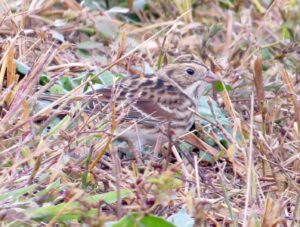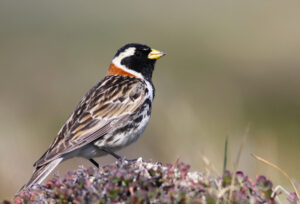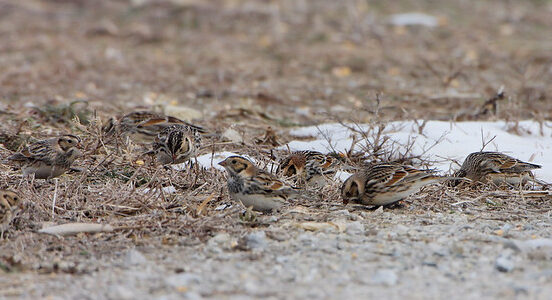Lapland Longspur, Calcarius lapponicus
Bill Rowe
Have you ever heard of a Lapland Longspur? Maybe not, if you aren’t yet an intense birder, and there are some good reasons for that, starting with the fact that its breeding grounds lie in the Arctic tundra, all around the globe but thousands of miles to our north. In fact, it is one of only a few passerines (small land birds) that manage to nest up there, among all the waterfowl, shorebirds, and raptors, and it can be incredibly abundant, singing on territories from Alaska and Canada to Norway and Russia. Biologists have estimated that there may be something like 40 million of these birds on our continent alone, and several times that many worldwide. In the fall, here in North America, they come south in flocks that spread out over the farm fields and prairies of the Midwest and Great Plains, with smaller numbers all the way to the east and west coasts. Once here, they normally stick to those barren-looking open fields of dirt and stubble—an inhospitable habitat, our version of the tundra—and even if you know they are there, the flocks can be fiendishly hard to study, as they bound around in the air and then suddenly land, disappearing into the dried vegetation. The name “longspur” refers to the long nail on their hind toe; this is shared by three close relatives that live only in North America and are much less widespread than the Lapland. Check your field guide!
IDENTIFICATION: The banner photo, above, shows a group of Lapland Longspurs in their normal habitat—or at least, that’s how they look if you happen to see them near the roadside, or maneuver yourself close enough with binoculars and scope. Then you can make out the black facial frame against a buffy or yellowish ground color; the white wingbars with a reddish panel between them; the blackish streaking on the breast and down the flanks; and the conical, sparrow-like bill. All these features distinguish them from Horned Larks, which have much plainer brown body plumage, different head markings, and a thinner bill, and also from any sparrow, in addition to the fact that sparrows don’t fly high around fields in cohesive flocks as the larks and longspurs do. The narrow white edges to their tails are shared by other birds of open country (again, the larks), so this is not a useful field mark. And because of their migration timetable, we almost never see the males in their handsome breeding plumage (below, right). A final, excellent way of identifying them is by calls: they may give a clear “teeeu” and/or a fast, short rattle, like “prrrt.” If you hear both calls from a flock, it’s this species.
ST. LOUIS STATUS: A common cold-weather migrant, most numerous November and March, in habitat described above; found in winter too but usually in smaller numbers.
Learn more and listen to the songs and calls of Lapland Longspurs here.


Male in breeding plumage




